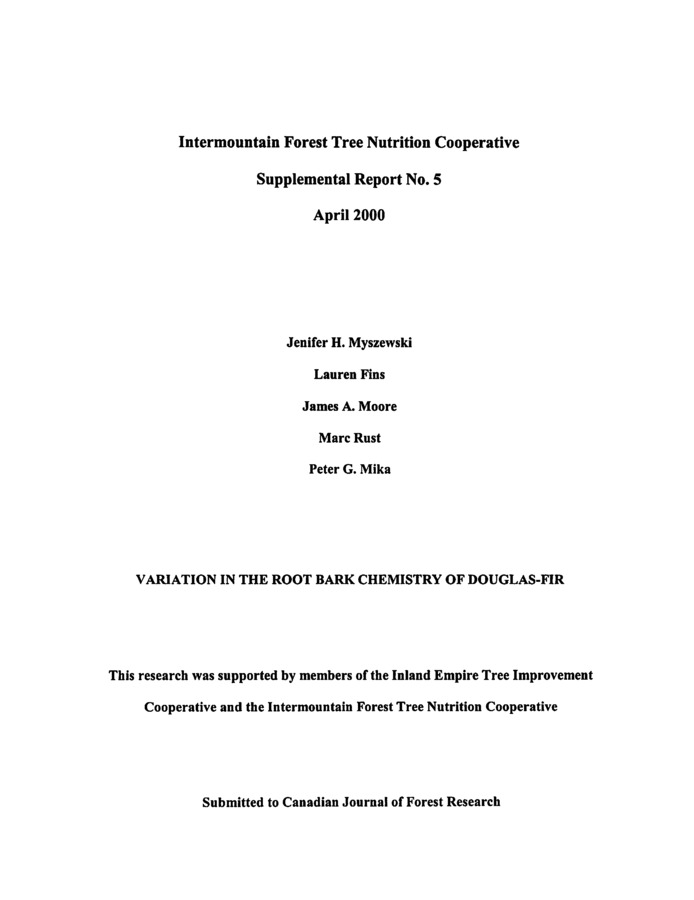PDF
Variation in the Root Bark Chemistry of Douglas-fir Item Info
- Title:
- Variation in the Root Bark Chemistry of Douglas-fir
- Creator:
- Myszewski, J.H.; Fins, L.; Moore, J.A.; Rust, M.; Mika, P.G.
- Date Created (ISO Standard):
- 2000-04-01
- Approximated Date:
- yes
- Description:
- Several studies have linked high phenolics:sugar ratios in the inner root bark tissue of Douglas-fir (Pseudotsuga menziesii (Mirb.) Franco) to decreased susceptibility to Armillaria spp. While these studies have identified environmental factors that influence root chemistry, none have examined whether the phenolics:sugar ratio is genetically controlled. In this study, the effects of genetics and environment on Douglas-fir root bark chemistry were investigated. Significant differences in root bark chemistry of 15-yr-old Douglas-fir were detected among 20 open-pollinated families and 2 sites in northern Idaho. Family, site and the family x site interaction were significant sources of variation in the concentrations of sugar, starch, protein-precipitable tannins, and phenolics as well as in the phenolics: sugar ratio. Single-tree narrow-sense and family heritability estimates revealed that 20-24% of the variation in the phenolics:sugar ratio can be attributed to genetic differences, while around 60% of the variation in sugar concentrations can be attributed to genetic differences. Family and individual narrow-sense heritability estimates for 12-yr height growth were 0.62 and 0.54, respectively. While the correlation between height and the phenolics:sugar ratio was not significant, three families above the seventieth percentile in height growth expressed above average phenolics: sugar ratios at both sites. Should a high phenolics:sugar ratio prove effective in selecting genotypes for resistance to Armillaria infection, these results suggest that it would be possible to do so without sacrificing families with superior height growth in a tree improvement program. Gains could be made even more efficiently by selecting for low sugar concentrations.
- Subjects:
- research (document genres) roots (plant components) trees statistics
- Location:
- North and Central Idaho; Eastern Washington; Western Montana; Northeastern Oregon
- Publisher:
- Intermountain Forest Tree Nutrition Cooperative, University of Idaho, College of Forest, Wildlife and Range Sciences, Moscow
- Source:
- Myszewski, J.H., L. Fins, J.A. Moore, M. Rust and P.G. Mika. 2000. IFTNC Supplemental Report No. 5. Variation in the Root Bark Chemistry of Douglas-fir. IFTNC, College of Natural Resources, Univ. of Idaho, Moscow.
- Source Identifier:
- Variation_in_the_Root_Bark_Chemistry_of_Douglas-fir_IFTNC_2000
- Type:
- Text
- Format:
- application/pdf
- Language:
- eng
Source
- Preferred Citation:
- "Variation in the Root Bark Chemistry of Douglas-fir", Idaho Forestry Research Collection, University of Idaho Library Digital Collections, https://www.lib.uidaho.edu/digital/forestryresearch/items/forestryresearch922.html
Rights
- Rights:
- In copyright, educational use permitted. Educational use includes non-commercial reproduction of text and images in materials for teaching and research purposes. For other contexts beyond fair use, including digital reproduction, please contact the University of Idaho Library Special Collections and Archives Department at libspec@uidaho.edu. The University of Idaho Library is not liable for any violations of the law by users.
- Standardized Rights:
- http://rightsstatements.org/vocab/InC-EDU/1.0/

